Hens and chicks are lovely succulents grown both indoors and outdoors. They can look great in containers. While growing in pots, repotting them becomes essential.
But how would you know when to repot hens and chicks? Let’s find out.
Generally, hens and chicks should be repotted during the spring and summer seasons. Hens and chicks are fast-growing succulents that produce many offsets every year, so you need to repot them to ensure they have enough space to grow. Also, repot the plant if they are suffering from root rot.
If you don’t know about the right time to repot hens and chicks, this guide will help you. Here, I will discuss the right time to repot these succulents. Along with that, I will also share a step-by-step guide to repot hens and chicks correctly.
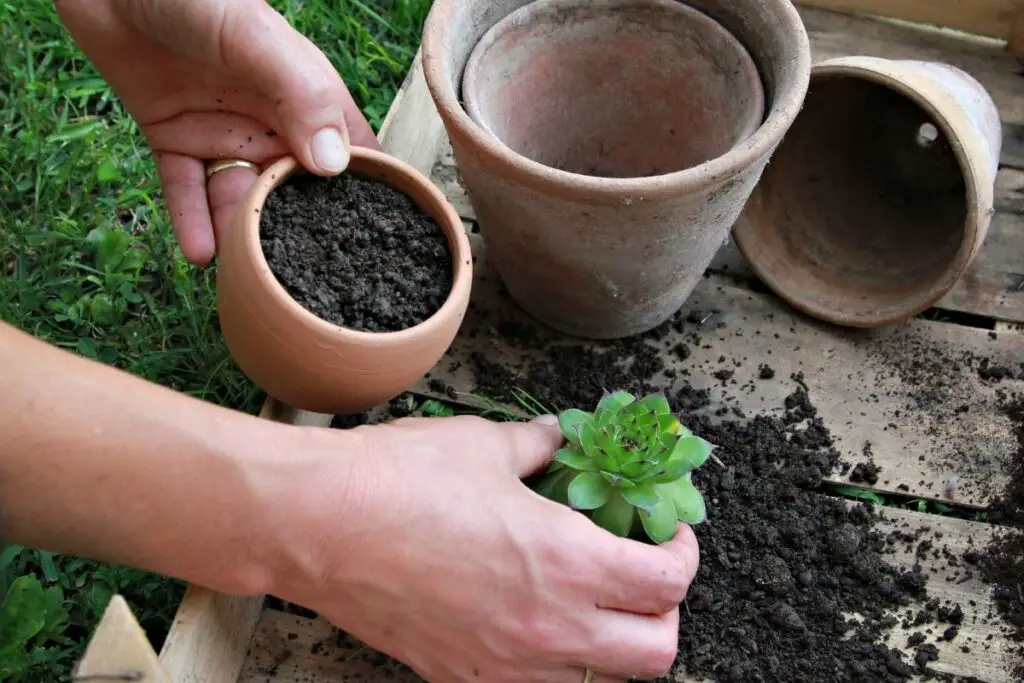
Why should I repot Hens and Chicks?
There can be different reasons behind Hens and chicks requiring repotting.
Hens and chicks will get new soil.
When you bring a new plant home, along with its container, it stands over a flimsy container and generic soil.
Repotting it in a new pot with the right potting mix will give it a perfect growing condition.
Do this after 1-2 weeks of bringing a new plant home.
Over time, the soil gets depleted.
The hens and chicks can grow and spread vigorously with new soil.
Repotting replenishes the soil and rejuvenates the plant’s growing conditions.
It keeps the plant healthy.
Compact soil is not suitable for any plant.
If the soil remains compact, the water flow will not be smooth.
The water will remain stagnant over the soil, the plant base will rot due to excess moisture, and the roots will remain dry.
Repotting before the soil turns compact prevents such conditions.
The new soil will be porous and well-aerated.
It will encourage the water to flow, soak the soil well, and improve ventilation.
Repotting will give the plant space to grow and multiply.
If you don’t shift the plant to a new big pot, it will grow its roots out of drainage holes.
It will immediately flow out of the drainage holes when watered, which means more roots than soil.
The plant will stop growing.
They won’t get enough space to produce babies.
The young rosettes will be too small and overcrowded.
But, if you repot them and give them space, there may be chances that they can deliver more babies.
Repotting Hens and Chicks gives the chance to separate the young offsets.
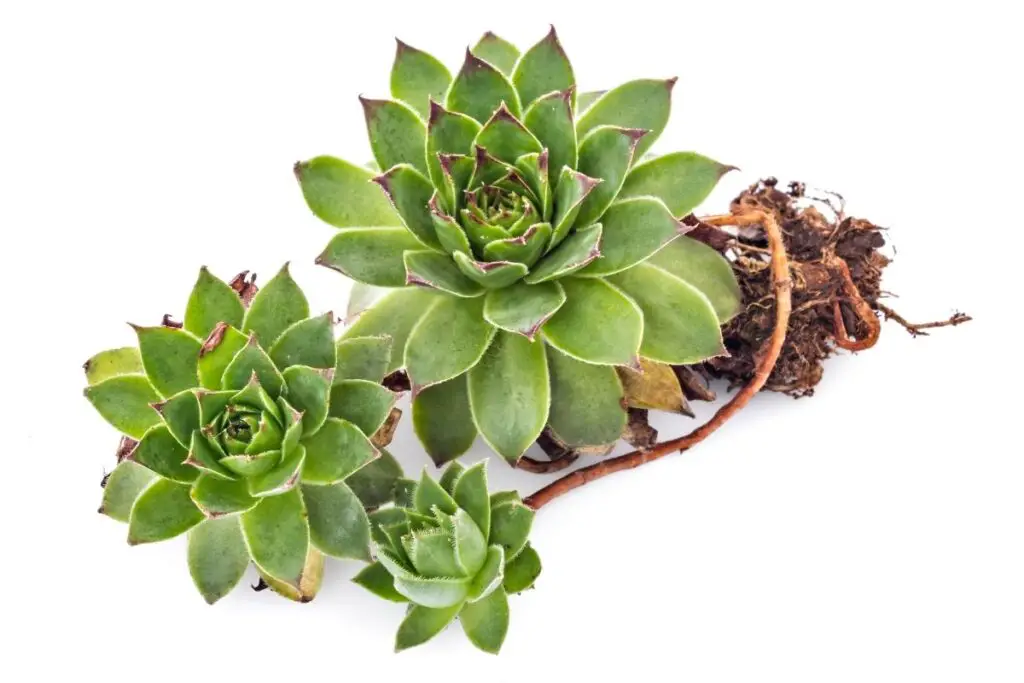
When you repot the Hens and Chicks, it is the perfect time to separate the babies from the mother.
When you plant the mother in a new pot, it will get space to produce more offsets.
Repotting gives you a chance to propagate the succulent with these offsets.
Also read: How Fast Do Hens And Chicks Grow?
Looking for gardening supplies? We have tested 100's of products before recommending them to you guys. Check out our best pick below:
| Image | Gardening Supplies | Best Price? |
|---|---|---|
 Top
Top Top
Top | Raised Garden Bed Kit | Check On Amazon |
 | XLUX Soil Moisture Meter, Plant Water Monitor, Soil Hygrometer Sensor for Gardening, Farming, Indoor and Outdoor Plants, No Batteries Required | No Results |
 Top
Top Top
Top | 82 Pcs Garden Tools Set and Extra Succulent Tools Set | Check On Amazon |
 | Joeys Garden Expandable Garden Hose with 8 Function Hose Nozzle, Lightweight Anti-Kink Flexible Garden Hoses, Extra Strength Fabric with Double Latex Core, (50 FT, Black) | No Results |
 Top
Top Top
Top | Dual Chamber Compost Tumbler | Check On Amazon |
 Top
Top Top
Top | Sunnyglade Plant Stakes | Check On Amazon |
 Top
Top Top
Top | Organic Cold Pressed Neem Seed Oil | Check On Amazon |
 Top
Top Top
Top | Mighty Mint Gallon :-Insect and Pest Control Peppermint Oil | Check On Amazon |
 Top
Top Top
Top | Scotts DiseaseEx Lawn Fungicide | Check On Amazon |
 Top
Top Top
Top | Jacks Classic 20-20-20 All Purpose Fertilizer | Check On Amazon |
 Top
Top Top
Top | 30,000 Seeds Pollinator Attracting Wildflower Mixture | Check On Amazon |
 Top
Top Top
Top | Survival Vegetable Seeds Garden Kit-Over 16,000 Seeds | Check On Amazon |
When should I repot hens and chicks?
Three scenes will tell you when to re-pot hens and chicks:
- When the roots are growing out of drainage holes
- The pot got covered with chicks.
- When the plant is suffering root rot.
Repot hens and chicks when roots come out of drainage holes.
When you plant a new Hen and Chicks, it stands over a tiny pot, depending on its size.
But, over time, it will grow more roots that can come out of the drainage holes.
When the roots of your Hens and chicks start coming out of the drainage holes, it is time to repot them.
If not repotted, they will stop growing due to a lack of space.
Though these plants like being overcrowded, they produce chicks in a big pot.
But when the mother plant is alone in a small pot and outgrowing its roots, repotting timely is necessary.
Repot when the container has too little room for the young offsets.
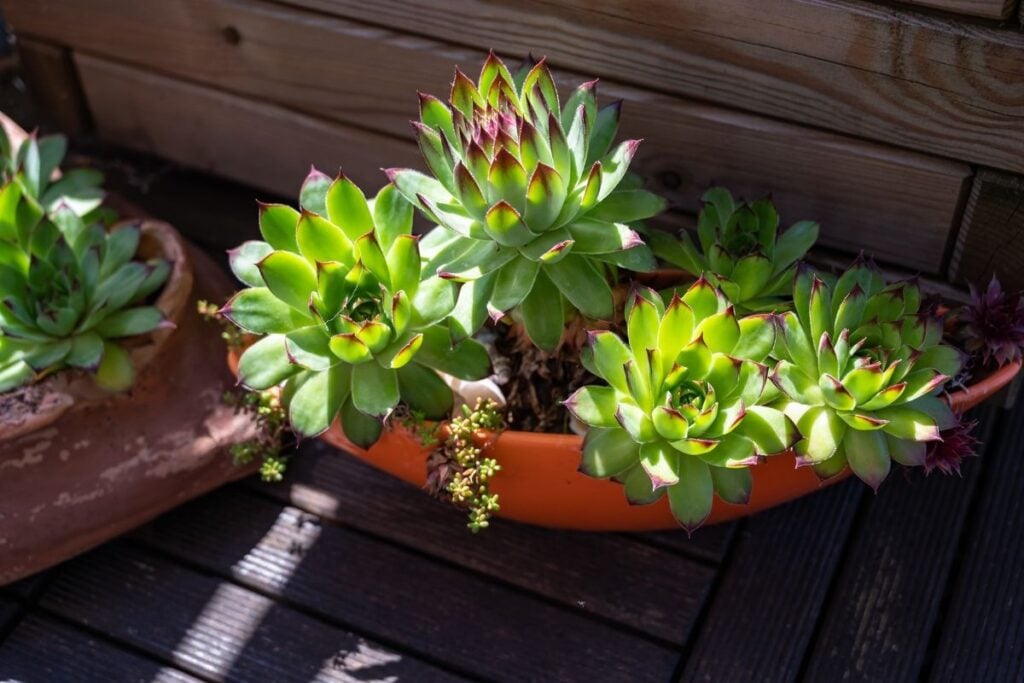
One hen can produce at least 2-6 chicks in one season.
Sometimes, it multiplies 1-2 times, depending on the variety.
The larger varieties of hens and chicks are pretty big than the other varieties.
The large ones will need more space to grow.
If you see that the babies of larger varieties are tiny, it means the plant needs to be repotted in a bigger pot.
Sometimes the babies will fall from the container and keep hanging.
The babies of the small offsets remain close or on top of the mother plant and are small.
Still, you need to repot them.
It will promote vigorous growth, and a bigger pot can prevent overcrowding.
Also read: Do Hens And Chicks Multiply? (How Fast, How Much)
Emergency repotting
Hens and chicks are famous for being drought-tolerant succulents.
It is because they can store water in their broad leaves and stems.
If you constantly water them without letting the soil dry, they will quickly start suffering from overwatering.
The leaves will feel soft and mushy.
They will also turn yellow or brown.
If you remain ignorant about the situation, your plant will begin to rot.
First, the rotting starts with the roots and then slowly progresses to the center of the rosette and then to the whole plant.
You need to repot the hens and chicks when the rot is limited within the roots.
It will save the plant from dying.
Signs that your Hens and chicks need repotting
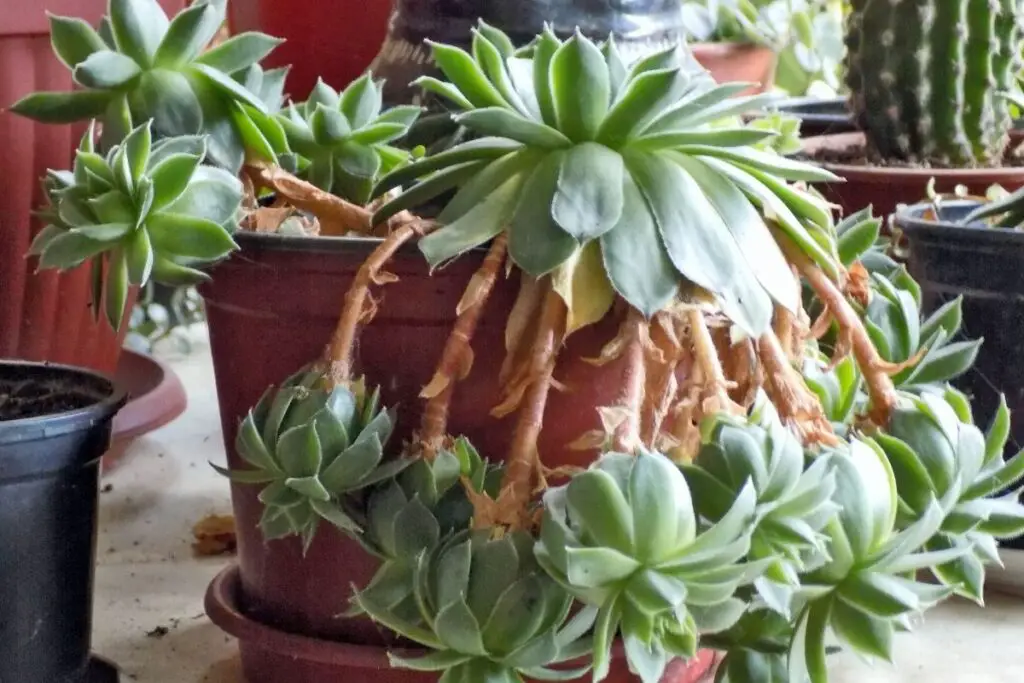
The following symptoms indicate that your Hens and chicks require repotting:
- Water is not soaking the whole soil and draining too fast.
- Roots growing out of the potholes.
- Despite getting adequate light, water, and other needs, they are not growing.
- The plant doesn’t look healthy.
- The chicks are growing very small and even falling off.
- For root rot, the leaves will turn dark and mushy.
If you don’t repot them yearly at a fixed time, at least repot when you watch the above signs in your Hens and Chicks.
Also read: 13 Tips For Growing Hens And Chicks
When is the best time to repot Hens and chicks?
Repotting will not show good results if done at any random time of the year.
The best time to repot is during the early spring, just before the plants grow.
Spring is their growing season, and they can quickly recover from transplant shock.
You can re-pot in the summer, provided the temperature is not much high (80-90°F all the time).
Transplant shock, along with hot summers, is too much stress for the hens and chicks to handle.
Though they will fight back as they are hardy-succulents, still, it is better to avoid.
Do not repot in the fall or winter.
Hens and Chicks slow down their growth when the temperature starts dropping from the second half of the fall.
They remain dormant in winter.
So, if your plant faces transplant shock, it won’t recover.
It can further give rise to other crises.
If you just want to shift the plant from one pot to another without changing the soil or disturbing its roots or growth, you can do it at any time of the month.
Though you can re-pot them in the summer and fall, it is better to do it in the spring.
Spring is the best time.
Winter has just finished, and the plants are just out of hibernation.
They will thrive with all their energy.
Repotting in such conditions can boost their growth and quickly recover from transplant shock.
Also read: Are Hens And Chicks Annual Or Perennial?
How often should I repot Hens and chicks?
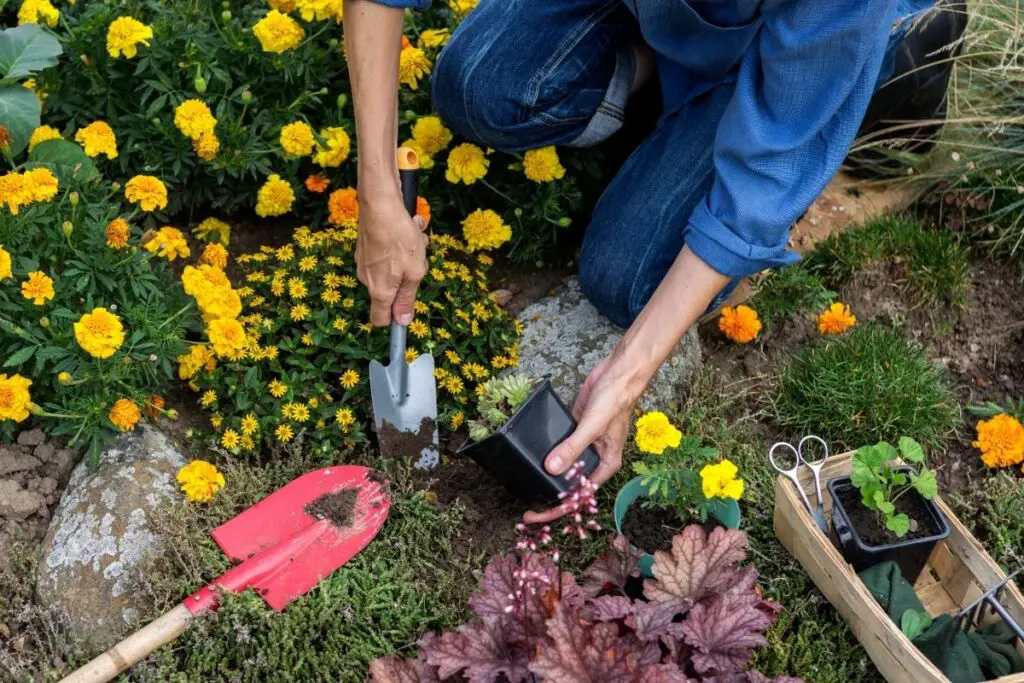
The young plants grow vigorously, so they will need repotting frequently.
Check if the roots are growing out of potholes.
After planting hens and chicks, they will be mature within a couple of months.
They are fast-growing succulents.
When the temperature rises above 58°F, they will produce chicks.
That is why hens and chicks should be repotted every year.
With repotting, they will get more space to grow more and multiply more.
If you don’t repot, the offsets will grow closer, smaller and the container will start cracking.
Sometimes, the offsets will come out of the container and hang out.
Such repotting frequency during root rot is not possible.
Repotting due to root rot is a kind of urgency.
If this happens, don’t wait for the growing season or completion of one year.
Do it as soon as possible.
Also read: Hens And Chicks Temperature Tolerance: (How Cold, How Hot?)
What kind of soil is suitable for Hens and chicks?
The only essential factor about the soil for hens and chicks is drainage.
The soil must be well-drained and don’t need to be rich in nutrients.
Hens and chicks produce auxins to stimulate their growth.
One of the best soil mixes for potted hens and chicks is commercial cactus and succulent potting soil mix.
It contains perlite and pumice that improve drainage to a great extent.
If you want to make your potting mix, below are some recommendations:
1st recommendation:
- 25% Potting soil
- 50% Sand
- 15% Perlite/Vermiculite
- 10% Compost/Worm casting
2nd recommendation:
- 50% Garden soil/Potting soil
- 50% Sand
- A handful of Compost
Try any of the above for the hens and chicks for good drainage.
Also read: What Kind Of Soil Do You Use For Hens And Chicks? (+Best Soil Mix)
What is the suitable planter for repotting Hens and chicks?
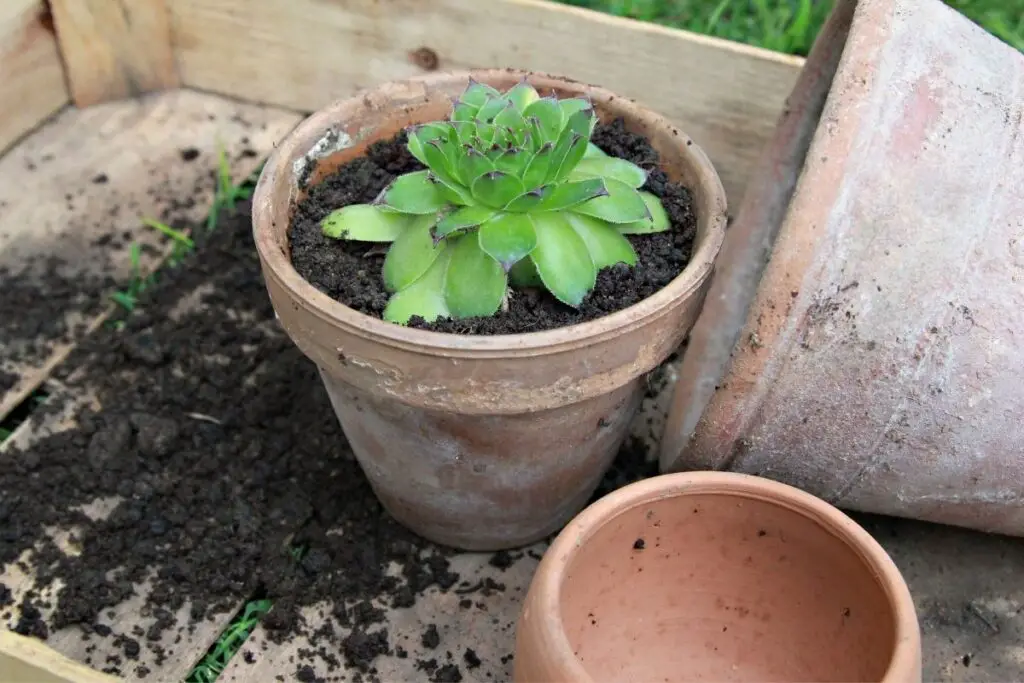
Three things need consideration when it comes to selecting an ideal pot for these succulents:
- Size
- Material
- Drainage holes
The size of the container should be only 1-2 inches bigger than the current one.
Hens and chicks don’t require too big or deep pots.
A too-big pot will need more soil.
When watered, it will take a long time to dry completely.
It can cause overwatering and root rot.
Also, don’t use a too deep container.
Hens and chicks have shallow roots, so a shallow container helps spread the roots.
If you always overwater your plants, use terracotta pots.
They can absorb the moisture quickly and keep your plant dry.
It can save your plant from overwatering.
A drainage hole is a must. The water will remain still in the pot and soil without the hole.
In such conditions, the roots will stay wet for a long time and eventually begin to rot.
Make sure your pot has it. Otherwise, drill it yourself.
Also read: How To Plant Hens And Chicks In A Pot? (A Step-by-Step Care Guide)
How to repot Hens and chicks? – Step-by-step guide
Repotting is not a difficult job. You must be a little careful about it.
Finally, let’s discuss the steps of repotting.
Things required:
- Container
- Knife, gardening spade, or forks
- Soil mix and extra gravel
- The plant
Steps to repot Hens and chicks
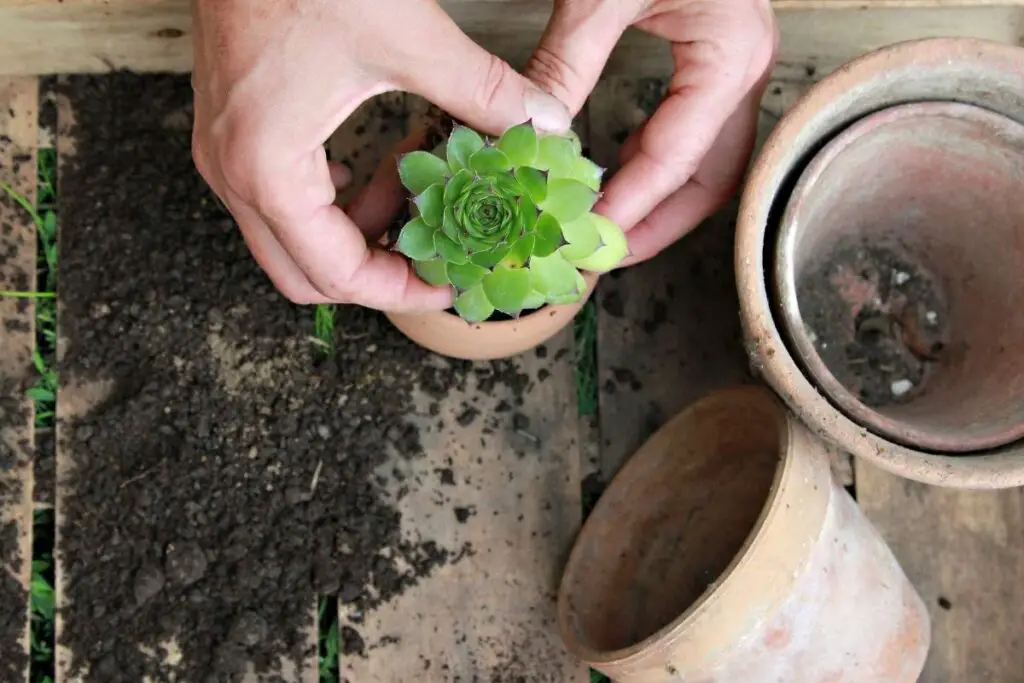
Plan it a few days back if you want to repot hens and chicks.
Step 1: Let the whole soil get bone-dry. When the soil gets dry, apply water to the plant very well.
It will make taking the plant out easy.
Step 2: The next day, prepare yourself.
Tap the sides of the pot to loosen the soil.
If it is stubborn, take the help of a knife or gardening tools to loosen the soil. Make sure not to hurt the roots.
Step 3: Once the plant is out, remove the maximum dirt from the root portion.
Don’t wash the roots as you do with other plants.
Only use your hand to remove the maximum soil possible.
Step 4: Trim them if the roots have become mushy, black, and smelly.
Don’t worry. These succulents will develop roots again.
Step 5: Take the container and fill it half with the soil mix. Mix a little bit of water.
It helps the plant to get some moisture after settling.
If the soil mix is well-drained, it will drain the excess moisture.
Step 6: Place the plant in the middle. If there are roots, spread them properly.
Separate the chicks and plant them in separate pots.
Cover the root ball and surrounding area with the remaining soil mix and press well.
Step 7: Keep it in its previous location if it was doing well there.
Whether indoors or outdoors, go for directions like south or west for maximum sunlight.
For the young plants, shade them for 1-2weeks and then give them light.
Water after 2-3 days. Keep the soil slightly moist.
Final thoughts
Repotting hens and chicks give them more space to grow faster and produce more young offsets. Another good advantage is that they get new soil which helps in good drainage, water flow, and ventilation.
Repot them every year to give them more space to grow and multiply. It also prevents the soil from turning compact. Repot during the springtime. But if root rot is the problem, re-pot immediately.
Choosing a porous material pot with drainage holes will help prevent excessive moisture. Within 2 weeks, the plant will begin to grow and multiply like before. Water the plant after 2 to 3 days, when the soil gets dry.
FAQs
Should I fertilize after repotting?
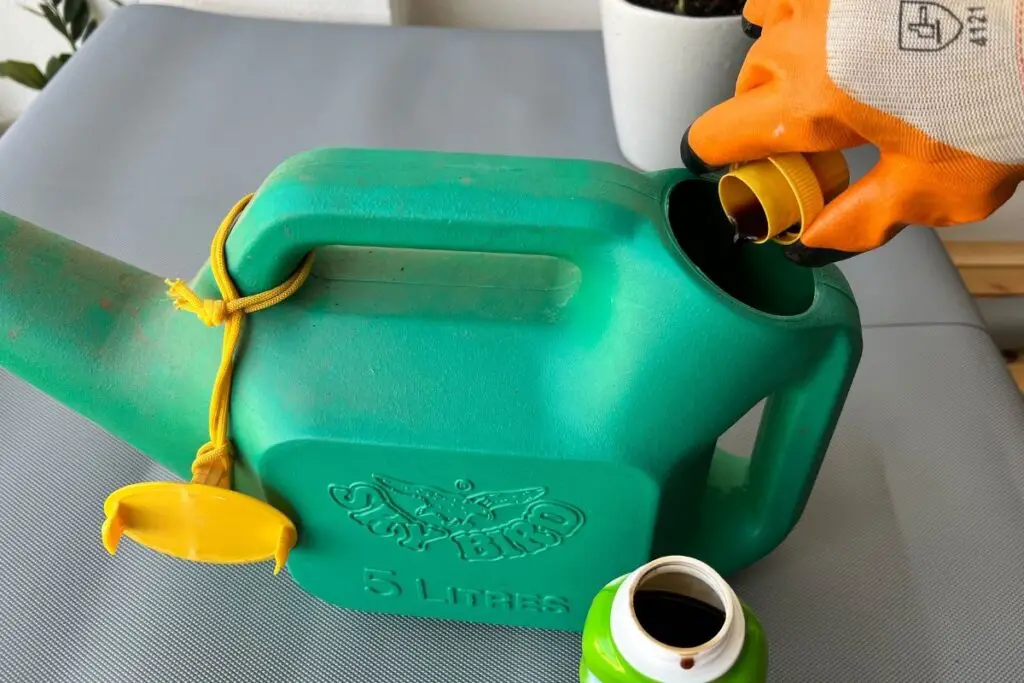
Generally, hens and chicks don’t need feeding. But you can do it to increase their growth rate and offsets.
Don’t fertilize immediately after repotting.
Once the Hens and chicks get adjusted to the new environment, feed them slightly.
Use a mild, balanced fertilizer diluted to half the strength.
Also read: Do Hens And Chicks Need Fertilizer? (+Best Fertilizer For Hens And Chicks)
What will happen if I don’t repot them?
If the pot you have taken is big enough for the hens and chicks (it shouldn’t be too big), you don’t have to repot them every year.
When they deliver chicks, you can separate them from time to time.
It will automatically give them more space to grow and multiply.
However, you must repot them after a year or two to give them new soil. It can boost the growth of your Hens and chicks.
Reference: Wikipedia, Iowa State University of Science and Technology, The University of Arkansas Division of Agriculture, NSDU, The Ohio State University, Missouri Botanical Garden.
